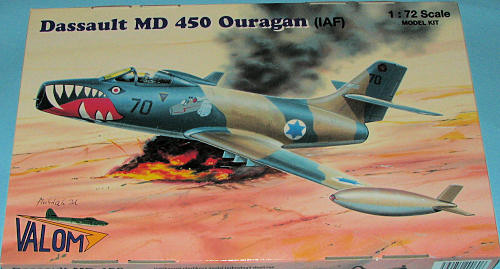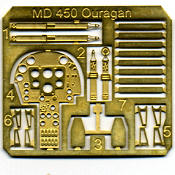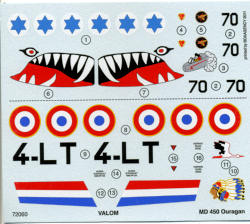
Valom 1/72 Dassault MD.450 Ouragan
| KIT #: | 72060 |
| PRICE: | $ |
| DECALS: | Two options |
| REVIEWER: | Scott Van Aken |
| NOTES: | New tool multi-media kit |

| HISTORY |
As citizens of an occupied country, the French were not able to contribute significantly to the great strides made in aircraft design made duringWorld War II. After the war, aviation designerMarcel Dassault was eager to re-establish the aviation industry with an all-French jet fighter, which was outlined in 1947. The government response to the proposal was positive and prototype construction began soon after the design was finalized.
Detailed design work on the new aircraft, which was given the designation M.D. (Marcel Dassault) 450, began in October 1947, with construction beginning on 7 April 1948 at Dassault's factory inSaint-Cloud. A French government contract for three prototypes followed on 7 December 1947. The first Ouragan fighter flew on 28 February 1949 withKostia Rozanoff at the controls. The M.D.450-01 prototype lackedpressurization, armament, and the distinctive wingtip fuel tanks. Powered by aRolls-Royce Nene 102centrifugal-flow jet engine generating 22.27 kN (2,270 kp/5,000 lbf) of thrust, the aircraft reached a top speed of 980 km/h (529 knots, 609 mph) and initial climb rate of 43 m/s (8,465 ft/min) in service trials in 1949. The 450 liter (118.9 US gal) wingtip tanks that would become the indelible feature of all Ouragans first appeared in December 1949. The pressurized second prototype, M.D.450-02, climbed to 15,000 m (49,213 ft), while the third prototype, M.D.450-03, was powered by aHispano-Suiza-licensed Nene 104 was used in weapons trials with 15 mm and later 20 mm cannon.
In 31 August 1949,French Air Force ordered 15 pre-production aircraft (later reduced to 12), which were eventually used for evaluation of various engines (includingSNECMA Atar), armament schemes, and payloads. The contract was signed on 15 December 1949. These aircraft were to be produced at Dassault's plants outside Paris. On 31 August 1950, Dassault received an order for 150 production Ouragans, with an additional 200 ordered in the following years.
Four production aircraft modified for rough-field operation with the two-wheel main landing gear with low-pressure tires retracting into a fairing added under the wing roots, and a brake parachute. The configuration was intended for operations inAlgeria, and the nickname came from the Arab word "baroud," meaning "battle." First flight 24 February 1954. Despite good performance, the project was abandoned in 1958 with two aircraft converted back to standard Ouragans.
In contrast to France and India, the Israeli Air Force was an enthusiastic Ouragan user. Seeking to augment its jet aircraft force of British Gloster Meteors, IAF initially considered French Dassault Mystère IIC and Canadian-built F-86 Sabre Mk.6 fighters. Due to development problems with the Mystère and a Canadian embargo on the Sabres, the order was changed to Mystère IVAs, with a batch of Ouragans purchased as a stop-gap measure. By 1955, the IAF had received at least 75 aircraft, comprising a mix of newly-built and retired French Air Force examples.
Israeli Ouragans entered combat on 12 April 1956, shooting down an Egyptian Vampire. At the onset of the Suez Crisis on 29 October 1956, Ouragans shot down an additional four Vampires. The two documented encounters with Soviet Mikoyan-Gurevich MiG-15 fighters (also powered by the Nene engine but with a more modern swept wing) ended with one Ouragan surviving several 37 mm (1.46 in) cannon hits to fly the next day and one MiG-15 being heavily damaged after it entered a turning dogfight with the Ouragans. The poor training of the Egyptian pilots who were consistently unable to realize their advantage in numbers as well as the MiG-15's speed and climb characteristics helped Ouragans to survive despite their inferior performance. On 31 October, a pair of Ouragans armed with rockets strafed the Egyptian destroyer Ibrahim el Awal (ex-HMS Mendip), resulting in the capture of the ship.
The Ouragans were relegated to advanced training shortly after the Suez Crisis, although they saw more combat in the 1967 Six-Day War. In 1975, the IAF sold 18 Ouragans to El Salvador, where they remained in service until the late 1980s.
| THE KIT |
 This one is quite typical of the newer Valom kits in that the surface detailing is superb (assuming you like the 'pock mark rivet' look) with the moldings nice and crisp. Only a teeny amount of flash was noted on the single major sprue of injected plastic. There are two smaller sprues carrying weapons along with a somewhat thick clear one-piece canopy. Resin is used for the bang seat and there is a small photo etch fret for some interior details (such as the main instrument panel and its accompanying acetate instrument sheet), and the bands around the rockets.
This one is quite typical of the newer Valom kits in that the surface detailing is superb (assuming you like the 'pock mark rivet' look) with the moldings nice and crisp. Only a teeny amount of flash was noted on the single major sprue of injected plastic. There are two smaller sprues carrying weapons along with a somewhat thick clear one-piece canopy. Resin is used for the bang seat and there is a small photo etch fret for some interior details (such as the main instrument panel and its accompanying acetate instrument sheet), and the bands around the rockets.
 The interior is well appointed and includes nicely done sidewall planes. There are etched belts for the resin seat. The kit has a well done nose intake section with a separate lower gun panel. The wheel wells are separate items as are the wing tip tanks. Landing gear are nicely molded and the kit comes with weapons for all six of the wing pylons. On each wing, the central of the three is for the slick bomb while
The interior is well appointed and includes nicely done sidewall planes. There are etched belts for the resin seat. The kit has a well done nose intake section with a separate lower gun panel. The wheel wells are separate items as are the wing tip tanks. Landing gear are nicely molded and the kit comes with weapons for all six of the wing pylons. On each wing, the central of the three is for the slick bomb while  the other two are for stacked rockets. This is a basic early jet so no oodles of options or other bits are included.
the other two are for stacked rockets. This is a basic early jet so no oodles of options or other bits are included.
Instructions are well done with two folded sheets. The outer sheet is in full color and includes your paint reference chart and painting/markings guide. The construction steps include color information as well as Valom's usual very large parts/color blocks. Two sets of markings are included. First is the box art plane of the 113 Squadron in the later camouflage scheme of light earth, blue-grey over light blue. It includes the unit's huge shark mouth and a unit or personal badge. The second option is a bare metal version from EC 2/4 'Lafayette' that is currently in the French AF museum. For this option the modeler will need to paint the red flashes and stripes on the tip tanks. Decals are superbly printed by Boaagency and show no registration errors.
| CONCLUSIONS |
This is, to my recollection, the second Ouragan produced in 1/72 scale and may well be the best. The Heller kit, while nice, isn't as well detailed as this one and is from the raised panel line era of the 1970s. This one includes full armament and should build into a superb model.
| REFERENCES |
http://en.wikipedia.org/wiki/Dassault_Ouragan
June 2011
My thanks to www.valom.net for the preview kit. You can get yours at your favorite retailer or on-line shop. If you would like your product reviewed fairly and fairly quickly, please contact the editor or see other details in the